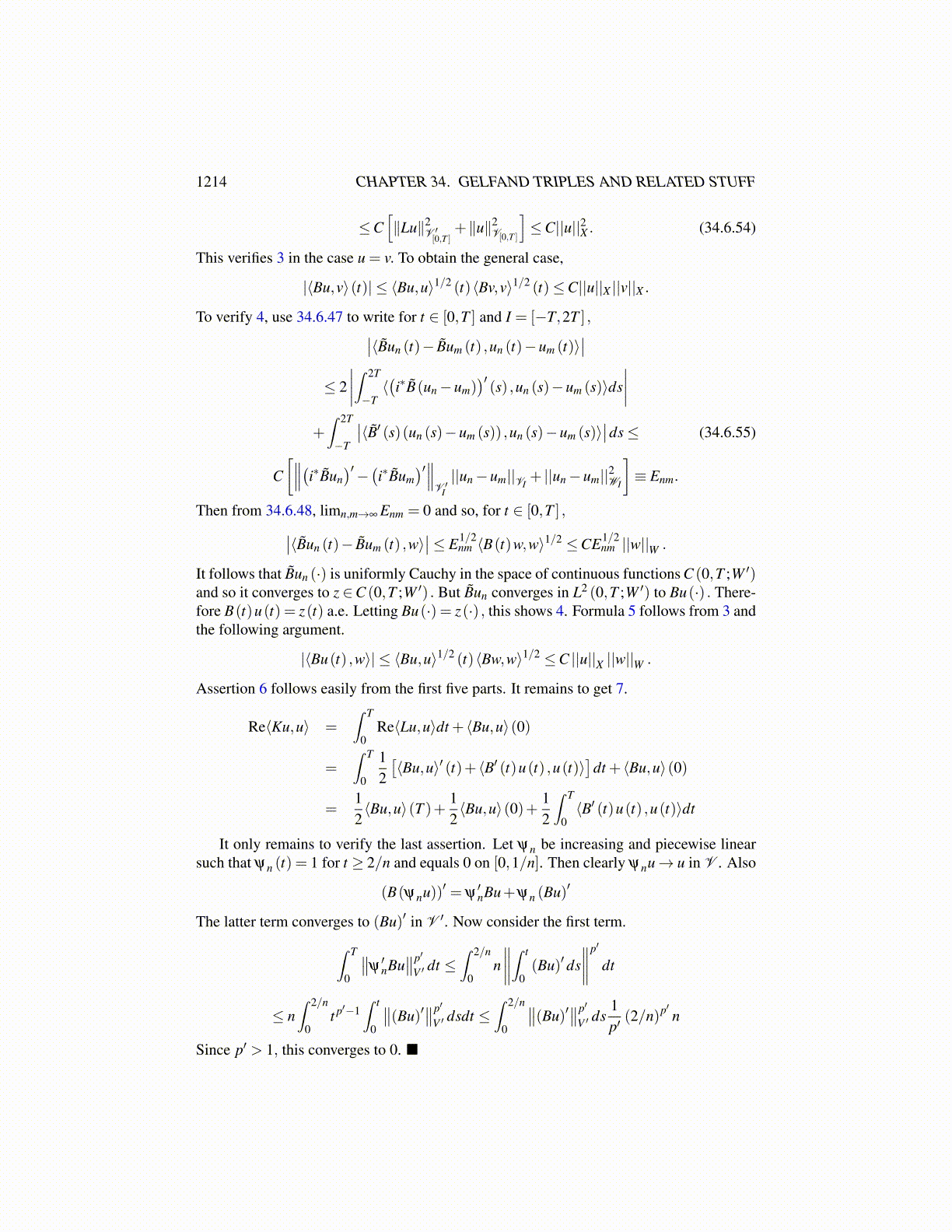
1214 CHAPTER 34. GELFAND TRIPLES AND RELATED STUFF
≤C[∥Lu∥2
V ′[0,T ]
+∥u∥2V[0,T ]
]≤C||u||2X . (34.6.54)
This verifies 3 in the case u = v. To obtain the general case,
|⟨Bu,v⟩(t)| ≤ ⟨Bu,u⟩1/2 (t)⟨Bv,v⟩1/2 (t)≤C||u||X ||v||X .
To verify 4, use 34.6.47 to write for t ∈ [0,T ] and I = [−T,2T ] ,∣∣⟨B̃un (t)− B̃um (t) ,un (t)−um (t)⟩∣∣
≤ 2∣∣∣∣∫ 2T
−T⟨(i∗B̃(un−um)
)′(s) ,un (s)−um (s)⟩ds
∣∣∣∣+∫ 2T
−T
∣∣⟨B̃′ (s)(un (s)−um (s)) ,un (s)−um (s)⟩∣∣ds≤ (34.6.55)
C[∥∥∥(i∗B̃un
)′− (i∗B̃um)′∥∥∥
V ′I||un−um||VI
+ ||un−um||2WI
]≡ Enm.
Then from 34.6.48, limn,m→∞ Enm = 0 and so, for t ∈ [0,T ] ,∣∣⟨B̃un (t)− B̃um (t) ,w⟩∣∣≤ E1/2
nm ⟨B(t)w,w⟩1/2 ≤CE1/2nm ||w||W .
It follows that B̃un (·) is uniformly Cauchy in the space of continuous functions C (0,T ;W ′)and so it converges to z ∈C (0,T ;W ′) . But B̃un converges in L2 (0,T ;W ′) to Bu(·) . There-fore B(t)u(t) = z(t) a.e. Letting Bu(·) = z(·) , this shows 4. Formula 5 follows from 3 andthe following argument.
|⟨Bu(t) ,w⟩| ≤ ⟨Bu,u⟩1/2 (t)⟨Bw,w⟩1/2 ≤C ||u||X ||w||W .
Assertion 6 follows easily from the first five parts. It remains to get 7.
Re⟨Ku,u⟩ =∫ T
0Re⟨Lu,u⟩dt + ⟨Bu,u⟩(0)
=∫ T
0
12[⟨Bu,u⟩′ (t)+ ⟨B′ (t)u(t) ,u(t)⟩
]dt + ⟨Bu,u⟩(0)
=12⟨Bu,u⟩(T )+ 1
2⟨Bu,u⟩(0)+ 1
2
∫ T
0⟨B′ (t)u(t) ,u(t)⟩dt
It only remains to verify the last assertion. Let ψn be increasing and piecewise linearsuch that ψn (t) = 1 for t ≥ 2/n and equals 0 on [0,1/n]. Then clearly ψnu→ u in V . Also
(B(ψnu))′ = ψ′nBu+ψn (Bu)′
The latter term converges to (Bu)′ in V ′. Now consider the first term.∫ T
0
∥∥ψ′nBu∥∥p′
V ′ dt ≤∫ 2/n
0n∥∥∥∥∫ t
0(Bu)′ ds
∥∥∥∥p′
dt
≤ n∫ 2/n
0t p′−1
∫ t
0
∥∥(Bu)′∥∥p′
V ′ dsdt ≤∫ 2/n
0
∥∥(Bu)′∥∥p′
V ′ ds1p′(2/n)p′ n
Since p′ > 1, this converges to 0.